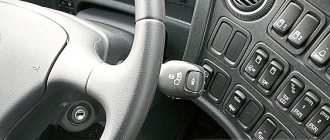Viva la VITO: morals and nerves
Pavel Gamankov, photo by the author
| Chassis manufacturer: | Daimler AG et Vitoria (Spain) |
| Model: | Mercedes-Benz Vito CDI 111 W639 |
| Start of sales in Russia: | 2004 |
| Price: | 27,400 euros |
How to classify it? An elite small-tonnage vehicle or a mini-van with an elite capacity? Obviously, the burghers did not just create a spacious commercial “bun” with the nerves of a car and the character of a truck. To the old van they added some attributes, aesthetics, comfort, brains and amputated all the shortcomings.
The bullet-shaped front end with sharpened optics and the embossed stylobate of the belt line give this shell monstrous dynamism. There appears to be a capsule inserted into the back of the van. Click the trigger on it and it will fly like a bullet through the back streets. No matter how you look at the Vito, it reveals primarily passenger notes. The styling traces the discoveries of Giorgetto Giugiaro, who first used lei for the Isuzu Piazza 25 years ago.
These impetuous motivations were clearly lacking in the previous generation Vito with the “638” body, which, despite the stability due to front-wheel drive, felt like a milked cow in corners. Clumsy and heavy, the car dragged its belly along curbs and gullies of unrepaired asphalt, and the advantages of front-wheel drive turned out to be insignificant before the long icy climb. To this must be added the limited rotation angle.
However, the new product does not shine with super cross-country ability, but now you can turn around in one go on a street with two, rather than four, lanes. The new product uses classic rear-wheel drive, traditional for Mercedes-Benz cars.
The black plastic bumpers of the van, combined with the side lines of the molding, create a textured strip along the entire perimeter of the car, which, according to transport safety adherents, has practical meaning: a car with a wide belt line beam, according to research by German specialists at Daimler-Benz, conducted in 1971, has less chance of getting into an accident.
A cargo van with side sliding and rear lift doors was tested. The installation of rear swing doors is not provided even as an option, which can be considered a clear hint from the designers towards exclusively urban use of the car. This van in the city center may never be able to drive its stern up to the unloading point. And loading and unloading delicate cargo in the rain and snow in a city center filled with cars is better with the rear door raised! The main thing is to park the car with its stern closer to the porch.
The use of rear vertical lights made it possible to make the lift door as wide as possible, and the door opening to be almost square (1350x1230), which makes it possible to load even standard Euro pallets into the body. But you shouldn’t forget about the carrying capacity of the Spanish-German truck - in the standard configuration it is limited to 980 kg. As our tests have shown, it is dangerous to load more, the rear spring suspension noticeably squats even with the permitted loads, and with full ballasting on the radius of the exit ramps of Moscow interchanges, it seemed that now the rims at children's 50 km / h would come off the tires and the van would tip over. Nothing happened even at 70 km/h. The tires squealed like a half-cut pig, but the Vito held the road like a Porsche. There are, however, modifications of the Mercedes-Benz Vito with reinforced suspension, where the load capacity is officially increased to 1120 kg, but these cars have another drawback - you can drive into the center of Moscow in such a small vehicle only due to an oversight by the traffic police. In other regions of the country, where axle load restrictions are more flexible, it is worth remembering that an increase in load capacity by 140 kg entails a change in the design and behavior of the vehicle. This means additional discomfort from the “shimmy” effect, a different cost and a new driving experience. Verdict: The Vito is a high-speed express train. Capsule for fast delivery of cargo.
Car history
The story begins in 1995. In those years, at the DaimlerChrysler plant located in the northern part of Spain, they began to mass-produce the Mercedes Benz Vito “truck,” which proved to be a quality worker in the first year of use.
Interestingly, the very next year, 1996, the Mercedes-Benz Vito received the award for best van of the year.
At the beginning of 1996, a high-capacity station wagon from a German company was shown for the first time in Geneva, which appeared on the Vito platform, which was called the V-class. To increase comfort, instead of pneumatic elements, coil springs began to be installed on the rear wheels. In addition, we decided to improve noise insulation, interior decoration, and change the appearance with the help of hanging elements.
Mercedes-Benz Vito 1996
As a result, a vehicle was produced that contained the carrying capacity of a commercial vehicle, but with an increased level of comfort. The model began to be produced in 1997. The very next year, the cars were equipped with a light restyling - they began to install CDI power plants (running on diesel fuel), which used a Common Rail fuel supply system. They were able to improve the quality of the cars through visible modernization of the interior and internal equipment.
Photo of the first generation Mercedes-Benz Vito
Release of a new car
When 2003 came, the company, instead of radically improving cars, decided to release completely fresh products instead of outdated ones - Vito and Viano. The two cars that the company decided to release at the same time are similar in appearance, however, they differ in their constituent elements.
The new product was presented in 3 versions - as a full-fledged work vehicle, a cargo-passenger saloon and a capacitive minibus. Already in the cool autumn of 2003, the new Mercedes model began to gradually replace small-tonnage commercial vehicles.
Mercedes-Benz Vito 2005
Mercedes Vito of the second family comes with 3 body length variations - Comfort, Long and long Extralong, 2 wheelbase dimensions (3,200 and 3,430 mm), 2 roof options (low and high, where the useful volume is from 4.65 to 6.49 m3, respectively) . There are also 5 power plants, the power of which varies from 88 to 218 horsepower.
By the way, starting in 2005, they began to assemble the average version of the roof. One of the most attractive will be the Panel van, with a body volume of 6.49 m3, up to 1,140 kilograms of loading capacity, and the 6-seater Vito Mixto, representing combined cargo-passenger transportation with a trunk designed for 970 liters of usable space.
Restyling of the second generation Mercedes-Benz Vito
The model accommodates up to 6 people and transports considerable cargo goods, which is necessary for many industries, for example, construction, utilities, and so on. For those who are interested in the number of seats in the car, the Vito option will come in handy, which is designed to carry nine people, including the driver. Taking this into account, there will still be about one cubic meter of free space in the luggage compartment, where various things can be placed.
Mercedes-Benz Vito restyling of the second generation
Second generation appearance
The most important difference between the Vito 2nd family is a completely new body. If previously it had an angular appearance, now there is room for soft and energetic lines, which is clearly visible when looking at the nose and side of the car, with a proportional line from the bumper to the windshield and a calm transition to the side.
The details simply cannot be confused - they clearly have the family traits of Mercedes. External restyling includes a replaced radiator grille and effective stamping on the hood. The rear area of the vehicle also received vertical rear lamps.
Mercedes-Benz Vito second generation
Regardless of the wheel base, the new product comes with the latest side doors that slide smoothly. They made loading things into the car much easier. The doors installed at the rear, which received a swing operating principle, acquired an opening angle of 180 and 270 degrees. They are ordered to replace the rear door, which lifts up, making it easy to load any material. The trunk opening between the wheel arches is 1,277 millimeters.
If you pay attention to the opinion of experts, the Vito models that were produced at the very beginning had a better build quality than other cars after the 1988 update. Journalists note that after restyling, the car received poor quality adjustments to the body panels.
Mercedes-Benz Vito side view
Under the seats installed in front, space has been provided for the placement of various cargo, which entails an additional 200 millimeters of useful length for any wheelbase. The maximum weight allowed for transportation on the roof is 150 kilograms.
It's a pity, but the 2nd generation model was not immune to rust.
However, it’s nice that the V-class had painted bumpers and exterior rear-view mirrors. Following the restyling, the door handles began to be painted to match the body paint.
Second generation salon
Moving into the interior, it is clearly clear that the appearance has affected important details - the instrument panel, keys and air conditioning controls, pockets and modest niches for various things. At the top, the instrument panel has a compartment where an A4 folder can be placed.
The glove compartment has grown in the free space and now the volume is 11 liters. The seat on which the driver sits, together with the seat of the passenger sitting next to him, can be adjusted in the longitudinal direction. In addition, there is soft adjustment of the seats in height, backrest tilt and seat cushions. The interior has seats with built-in three-point seat belts.
Interior of the second generation Mercedes-Benz Vito
Such moments made the interior of the Mercedes Vito thoughtful and convenient for transporting passengers. A modification of the Marko Polo is provided, which has a lifting roof. In addition to the latter, the salon received a refrigerator and even a gas stove.
Utility vehicle modifications without rear glazing are called Mixto. The V-Class differs from the Vito by having a pneumatic suspension installed even in the basic configuration, which can lower the rear of the car and keep the ride height constant.
Salon of the second generation Mercedes-Benz Vito
Disadvantages of the interior
But the car also received shortcomings, and not every modification of the updated vehicle deserves high praise when compared with the previous family.
Some complain about the insufficient level of visibility, because the presence of a large A-pillar promises to obscure the view during a turn, and the headrest installed in the middle of the rear seat completely deprived the driver of the driver’s visibility.
When the sun is shining, the orange icons on the dashboard are difficult to notice. Therefore, in order to read information from the instrument panel, there is nothing left to do but use your hand to cover it from the sun’s rays.
Dashboard of the second generation Mercedes-Benz Vito
Speaking about the design of the Mercedes-Benz Vito W639, when compared with its predecessor, there is almost nothing that connects them. These are completely alien vehicles. The first thing that distinguishes them is the layout.
The previous model had front-wheel drive and a power plant located transversely, while the new generation received a longitudinal arrangement of the engine and gearbox. The drive has already begun to go to the rear axle. The drive had to be replaced due to two problems.
Second generation Mercedes-Benz Vito passenger seats
The first is that previous cars transmitted vibrations to the steering wheel - a rear-wheel drive system solved this problem. The second reason is passive safety. Provided that the previous generation of Vito passes a crash test, it will become clear that in the event of a collision, the power unit will go into the car's interior, which is fraught with bad consequences.
Loading items into the luggage compartment of a Mercedes-Benz Vito
When the motor has a longitudinal layout, it “goes” under the floor, which reduces the level of danger. On top of that, minivans with front-wheel drive had underloaded rear wheels, which was clearly observed in the back of a van.
Second generation power unit
The new generation has received a considerable selection of engines. There were 5 engines that met Euro-4 standards. These are power units with an in-line four, running on CDI diesel fuel of the 2nd family. Power varied: 88, 109 and 150 horsepower.
There was also the presence of V-shaped six-cylinder engines operating on gasoline, which had Bosch Motronic ME 2.8 injection function and produced 190 and 218 “horses”.
It’s nice that the engines in the new generation have become more dynamic, more environmentally friendly, and, what is important these days, more economical.
Second generation transmission
The basic configuration had a 6-speed manual transmission. V-shaped petrol “sixes” had a five-speed automatic transmission, which, if necessary, was installed on diesel units.
Thanks to improvements in the transmission, ride comfort has improved and the car has become more reliable on the road.
Second generation suspension
It is independent for four wheels. The front mechanisms have McPherson shock absorbers, on which anti-roll bar mounts are mounted. The rear suspension has spaced coil springs and shock absorbers.
Second generation brake system
All wheels are equipped with disc brakes, ventilated in front and standard in the rear. The standard equipment can regulate braking forces and has a hydraulic emergency braking system, Brake Assist.
Typical faults
During production, the car was twice called for service campaigns. The first was in 1998 due to problems with Continental and Semperit tires. The second - in 2000 to eliminate problems with the brake booster.
Vito's weakest point is corrosion. It's all about poor body protection. Rust appears literally everywhere. The first outbreaks, as a rule, appear on the lower corners of the doors, hood, and rear trunk door. Before you settle on a specific instance, you should take a closer look at the thresholds, floor and, if possible, look under the door seal.
If there are no traces of rust on the body, then it has probably been repaired. In most cases, this work is done hastily just to make the car look nice at the time of sale. Be on the lookout!
There are also electrical problems. In diesel versions, the glow plug relay is acting up. The starter, alternator, radiator fan, power windows and central locking often fail. The thermostat is another part that will soon need to be replaced. From time to time the air conditioning system and heater “show character”.
Before purchasing, be sure to check the operation of the side sliding doors, which jam if the guides are damaged. Owners complain about the very low quality of the interior plastic - it makes unpleasant sounds while driving.
Sometimes gearbox cables and universal joints fail. The 4-speed automatic transmission does not cause problems, provided that the operating recommendations for changing the oil are followed. The Vito's steering mechanism is not very durable - play appears quite quickly.
Mercedes-Benz Vito new generation
In 2014, the German company radically changed its attitude towards the minivan and showed a new generation. The Germans presented the Mercedes-Benz Vito W 447 modestly. This happened at the October 2014 Paris Motor Show. They began selling the new model in European countries in October of the same year.
The model will be available for purchase in the Russian Federation no earlier than November 2014. The very first generation of Vito, which was produced from the mid-1990s, was a simple, high-quality front-wheel drive car. The model was distinguished by a quite modest price tag and minimal ambitions.
Mercedes-Benz Vito W 447
The second family already has rear-wheel drive, with which it was produced before the advent of the 3rd generation. But the W 447 now comes with a choice of three drives: front-wheel drive, rear-wheel drive and all-wheel drive.
Since the start of production, more than 1,200,000 cars have been sold, which is very impressive. The new product, in reality, is an affordable and utilitarian variation of the beautiful new Mercedes-Benz V-Class.
However, the modest Vito model, with its small number of modifications that offer different powertrain options and drive types, can seriously compete with its “brother.”
Exterior
After watching videos and photographs showing the new product, there are many similarities with the appearance of the Mercedes-Benz B-Class. There was a place for decent and representative body shapes and lines, headlights made very stylishly, a solid false radiator grille with a large three-beam badge.
Photo of Mercedes-Benz Vito W 447
The car has an improved aerodynamic drag coefficient of 0.32 Cx. However, from the unpainted bumpers (only the Select equipment in the passenger version received bumpers in body color), swinging or lifting doors of the luggage compartment, simple light alloy rollers and even installed steel wheels with caps, it is clearly noticeable that the Vito 3 family is a workhorse " Despite its modesty, the W 447 looks great on a construction site, in front of a company office, or in the city center.
Interior
The interior of the third Vito family is very comfortable, ergonomic and practical. Of course, it is not as luxurious as the V-Class, but it is still modern and functional. The driver's seat provides the driver with utmost comfort. There are no unpleasant sensations even during long trips.
Interior of Mercedes-Benz Vito W 447
Many people understand that the Vito is often used for commercial purposes, which is why the driver spends long hours on the road. The salon has many compartments for storing various small items and bottles.
The luggage compartment of the “truck” and the cargo-passenger version of the Mixto provides for the presence of guides for attaching a European pallet, hooks for securing cargo on the floor and the side of the cargo compartment.
Passenger seats Mercedes-Benz Vito W 447
If you pay attention to the Vito Tourer passenger model, it can comfortably carry 8-9 passengers, including the driver. On the second and third rows, if necessary, it is possible to fold and remove the seats, which will turn the car into a large van.
Faulty parts
If the Vito is often used to transport heavy loads, the air springs may require replacement after 50,000 km.
Drive shaft bearings are not considered durable.
Transmission oil leaks are a chronic problem.
The brake discs last a relatively short time - too small for a heavy van.
Specifications
Third generation power unit
When purchasing a 3rd generation Mercedes Benz Vito, the company provided 5 engines operating on diesel fuel, which all meet serious Euro-6 environmental standards.
The weakest is the 1.6-liter, 88-horsepower turbodiesel 109 CDI. Next comes a similar power unit, but already developing 114 horsepower (111 CDI). Next come the 2.1-liter diesel engines 114 CDI with 136 horsepower and 116 CDI with 163 horsepower.
Mercedes-Benz Vito engine
The top option is the Mercedes-Benz Vito 119 BlueTEC engine, which has a volume of 2.1 liters. Such a power unit already develops 190 horsepower. Among the features of the new Vito, one can note increased efficiency by 20%.
For example, an 88-horsepower power unit in city mode does not require more than 7 liters. The most powerful engine consumes, which is very unusual, only 100 grams more. In part, this was achieved thanks to the introduction of the start/stop system.
Third generation transmission
The 1.6-liter engines operate with a six-speed manual gearbox. The model has a front-wheel drive layout. The 163-horsepower engine is already synchronized with either a six-speed manual gearbox or a 7G-Tronic Plus automatic transmission, which can be supplied as an option.
The model has a rear-wheel drive layout. The most powerful engine transmits torque to all wheels and is synchronized only with the 7G-Tronic Plus automatic gearbox.
Third generation suspension
The car's suspension was modified quite a bit. Although in general, there was no urgent need for this. The suspension of the new product provides comfortable movement, excellent handling and excellent directional stability. The 2014-2017 Vito has a fully independent suspension with McPherson struts in the front and a multi-link system in the rear.
Passenger versions of the Tourer even received comfortable shock absorbers and soft springs as standard, which are much better than those installed in the cargo versions. I didn’t like the noise insulation of the Vito cargo version a little.
The passenger version is slightly better, but it is still far from the noise insulation of the Mercedes Viano. Although you shouldn’t be surprised, because this is still a different class of cars.
Third generation steering
The steering wheel is very easy to control, which is achieved through the use of electric power steering. Therefore, driving a car is very simple and convenient.
Price and options
You can purchase compact utility vehicles from 2,050,000 rubles. This will be the basic cargo package with the weakest 1.6-liter diesel power unit producing 88 horsepower and synchronized with a 6-speed manual gearbox.
The top-end option will cost from 3,918,000 rubles for a 2.1-liter 190-horsepower engine with a 7-speed automatic gearbox.
Updated Mercedes-Benz Vito
Basic equipment includes systems that monitor the physical condition of the driver and tire pressure, an on-board computer, 8 airbags, ABS, ESP, blind spot monitoring systems and road markings, a simple audio system that supports MP3 and USB.
You can also install an advanced multimedia system, which has a color screen that supports touch input (works with music, phone, navigation system, rear view camera), and a crosswind stabilization system.
Reviews from car owners
Many drivers highly praise the car, especially the 1st generation. This is easy enough to explain. The second generation received rear-wheel drive, so in winter the car gets stuck almost everywhere it can. The only exception is when the car is loaded.
Many car owners note that they are generally satisfied with the purchase, and the impressions are very positive. The power unit (CDI) has good throttle response. Regardless of their age, many of them easily accelerate to 190 kilometers per hour. Of course, the Vito's ground clearance is not that high, but the model's cross-country ability is good. It is often difficult to warm up a car in winter, Webasto helps out. Don’t forget about the air suspension of the Mercedes Vito, which increases the level of comfort.
German quality is always praised, so the car can run for a long time, requiring only replacement of consumables. If you already have to buy a new part, you will have to pay a little more, since Mercedes parts have always cost more than the same domestic or Chinese cars.
But if you install a part, it will serve for a long time faithfully. There are almost no problems with an automatic transmission if you take care of it on time. In many ways, everything depends on the operating and maintenance conditions of the vehicle.
Manual transmission link
All transmission options for the Mercedes Vito are quite reliable and do not create serious problems.
In a car with a manual transmission, you should carefully and meticulously click through all the gears. There should be no play, gears should engage smoothly and not “snap out” while driving. Reverse gear should engage easily and the first time.
The manual transmission shifter, its cables and the gear shift mechanism under the hood on the Vito are a weak point; sometimes the gears are engaged with such difficulty that people break the handle trying to drive into gear.
Pros and cons of Mercedes Vito
Pros of the car
- Pleasant and stylish appearance;
- Good maneuverability;
- The latest generation provides a choice of 3 drive options - front, rear and all-wheel drive;
- Even the basic equipment is rich;
- When purchasing a new car, you can purchase the necessary options;
- Proven quality;
- High degree of security;
- Fast payback;
- You can change the car to suit your own needs;
- Improved aerodynamic component of the minivan (3rd generation);
- Comfortable and convenient interior;
- Possibility to travel with family;
- Comfortable steering wheel;
- Low fuel consumption;
- Quite torquey and playful power unit;
- Good visibility;
- The 3rd generation received a stylish color screen that supports touch input;
- Comfortable seating position for the driver and front passenger.
Cons of the car
- 3rd generation cars are a bit expensive;
- The 2nd generation Vito is very difficult to use in winter due to rear-wheel drive (poor traction with the road surface when the car is empty);
- The parts cost a lot of money;
- On the secondary market, most cars have already traveled hundreds of thousands of kilometers;
- Compared to the same Sprinter, in the Vito the height inside the car is quite small;
- It is not recommended to overload the car;
- In winter, it is difficult to heat the entire interior.
Engines
Gasoline:
R4 2.0 (129 hp) - 200, 113;
R4 2.3 (143 hp) - 230, 114;
VR6 2.8 (174 hp) - 280.
Diesel:
R4 2.2 (82, 102-122 hp) - 108 CDI, 200 CDI, 110 CDI, 220 CDI, 112 CDI;
R4 2.3 (79-98 hp) - 180 D, 230 TD, 110 D.
It's true that gasoline engines cause far fewer problems than diesel engines, but they consume a lot of fuel. Those who use the Vito as a commercial vehicle prefer diesel engines. Unfortunately, diesel engines have great difficulty in accelerating a car, even the most powerful ones.
There were two diesel units to choose from. All of them have an almost eternal timing chain drive. Which unit has proven itself best during operation? The 2.3-liter turbodiesel was the outsider. It has problems with the injection system - the injection pump fails. There are also cases of premature breakage of the generator drive belt and pump, and even burnout of the head gasket.
The 2.2-liter unit, despite its more complex design, is much more reliable and economical. Although here there are also problems in the injection system. Glow plugs fail quite quickly, usually due to a burnt-out relay.
Let's sum it up
Generally speaking, many people are satisfied with even the old Vito models. Most people still dream of buying a car like this. Thanks to the fact that the German company decided to release the 3rd generation of the model, where you can finally choose between front-wheel drive, rear-wheel drive and all-wheel drive.
The quality of the car as a whole and the interior itself are simply impressive. The power unit is quite sharp, allowing you to feel confident when overtaking and at high speeds. Quite low fuel consumption will only please car owners. Of course, there is a well-known problem - a rotting body, but any body requires care.
Mercedes-Benz Vito 2014
It’s nice that the company paid attention not only to the level of comfort, but also to the safety of the car. So, many of them have various systems designed to help the driver when driving a vehicle. There are also airbags. There is a lot of free space inside, passengers do not feel discomfort.
With three rows of seats, the luggage compartment is not record-breaking, but allows you to take the most necessary things with you. On top of that, you can use cargo transportation on the roof of the car. Mercedes Vito is pleased with the price. German quality has always been famous all over the world, and it’s nice that, despite quite a lot of “experience” on the road, the Mercedes Vito has once again proven this.
We advise you to read the article: Mercedes-Benz, classic German cars
Tales for VIP
The more tests we conduct, the larger the range of vehicles we cover, the more difficult it becomes to find competitors for comparison. We have to choose other comparison criteria. So this time we decided to list the data of machines with a carrying capacity of up to 1000 kg in the table. These are the numbers that limit entry into the center of Moscow, where similar equipment is mainly sold. Therefore, when viewing test data, keep in mind that the total weight of the vehicles being driven is different and they are, in general, intended for transporting sometimes completely opposite groups of goods. We hope this comparison will help you understand how much fuel you will save if you take a minivan rather than a cargo van to transport printed materials.
Mercedes-Benz Vito 2014
Read further:
GLC Coupe from Mercedes
Mercedes-Benz CLA 2022 update: what's new?
The first live photos of the serial electric Mercedes Benz EQC
Mercedes-Benz 300SL
Will Mercedes be different?
Mercedes-Benz G65 AMG











